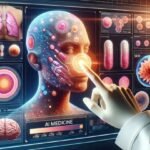Introduction

An AI-powered diagnostics represents the face of a medical revolution in a fast-changing healthcare landscape. Consequently, traditional diagnostic methods have always been limited on the human side, but AI has opened a completely new perspective on what is possible in the way we identify, understand, and treat medical conditions. From precision and speed, this breakthrough technology promises to increase diagnostic accuracy, reduce human error, and, ultimately, save lives.
Understanding AI-Powered Diagnostics:

The intersection of medical expertise and cutting-edge technology is what AI-powered diagnostics is. The central feature of artificial intelligence in medical diagnostics is the application of highly sophisticated machine learning software to interpret extremely murky medical data with unparalleled accuracy and effectiveness.
Key Components of AI-Powered Diagnostic:
- Advanced neural networks
- Deep learning algorithms
- Comprehensive medical databases
- High-performance computing systems

Benefits of AI in Medical Diagnostics
1. Unprecedented Accuracy
Machine learning in healthcare enables computers to identify subtle patterns that might escape human perception. AI systems can:
- Detect minute anomalies in medical imaging
- Cross-reference vast medical databases instantaneously
- Provide probabilistic diagnostic predictions
2. Enhanced Efficiency
Traditional diagnostics processes often involve:
- Time-consuming manual reviews
- Potential human errors
- Limited cross-referencing capabilities
AI-powered diagnostics eliminate these constraints by:
- Processing complex medical data within seconds
- Offering real-time diagnostic insights
- Reducing potential misdiagnosis risks
3. Cost-Effectiveness
While initial implementation requires significant investment, medical artificial intelligence ultimately delivers substantial long-term economic benefits:
- Reduced diagnostics time
- Minimized unnecessary medical procedures
- Improved resource allocation
- Streamlined healthcare delivery
Current Applications of AI Diagnostics
1. Radiology
AI algorithms can:
- Detect early-stage tumors
- Analyze complex X-ray and MRI scans
- Identify microscopic cellular changes
2. Oncology
Diagnostic technology in cancer research enables:
- Precise tumor classification
- Treatment response prediction
- Personalized therapy recommendations
3. Neurological Disorders
AI helps diagnose:
- Early-stage Alzheimer’s
- Parkinson’s disease progression
- Subtle brain structural changes

Technological Mechanisms
Deep Learning Algorithms
Neural networks simulate human brain processing by:
- Learning from extensive medical datasets
- Recognizing complex patterns
- Continuously improving diagnostic accuracy
Data Processing Techniques
AI systems leverage:
- Massive computational power
- Advanced statistical modeling
- Multi-dimensional data analysis
Challenges and Limitations
While promising, precision medicine through AI faces several challenges:
1. Data Privacy Concerns
- Protecting patient information
- Ensuring secure data transmission
- Compliance with healthcare regulations
2. Ethical Considerations
- Maintaining human oversight
- Preventing algorithmic bias
- Ensuring transparent decision-making processes
3. Technical Limitations
- Requirement of high-quality training data
- Complex integration with existing systems
- Continuous algorithm refinement
Future Prospects of AI-powered diagnostic
The future of AI-powered diagnostics looks incredibly promising:
- More sophisticated diagnostic tools
- Increased accuracy and speed
- Personalized treatment strategies
- Global healthcare accessibility
Frequently Asked Questions
Q1: How accurate can AI Diagnostic tools be?
This works in general — across many medical specialties — AI-powered diagnostics tend to achieve an accuracy rate of 90 percent — 99 percent or more, and in quite a few cases exceed human expert performance.
Q2: Can AI Replace Human Doctors?
AI is not built to replace human intelligence concerning that, the answer is no, AI is built to assist and augment medical professionals offering support illumination, and sifting the distinction making.
Q3: Which Medical Fields Will Benefit the Most from a PNG?
Diagnostic technologies driven by AI have entirely changed the face of radiology, oncology, pathology, neurology, and other healthcare disciplines.
Q4: But How Fast Can AI Give Diagnoses?
From limited data, AI can make a diagnosis in as little as minutes, even from days to minutes better than if you simply spread it out on the floor.
Q5: Is AI-powered diagnostic Expensive?
The downside of these first costs is that they are high at the front end but with time they save money on healthcare and produce far better patient outcomes.
Conclusion
AI-enabled diagnosis is a game-changing pathway in healthcare and brings more accurate, efficient, and personalized medical solutions. As technology progresses though, we see even more and more amazing technologies that will help us see further and further into the past as individuals suffering from the various medical conditions we currently can understand, identify, and treat.
From replacing human expertise, that’s the past, the future of healthcare is to enable pieces of medicine to work with the most powerful capabilities human beings can have.
Would it be possible for someone to go through a specific section and add something? Or would it be possible for someone to talk about something related to AI-powered diagnostics?




Pingback: The Sinister Side of Ai Diagnostics Companies in USA: Dark reality - glotarhub.com
Outstanding
Pingback: Revolutionary AI-Powered Diagnostics: Transforming Healthcare Accuracy and Patient Outcomes – GlotarLife